Page 282 of 474
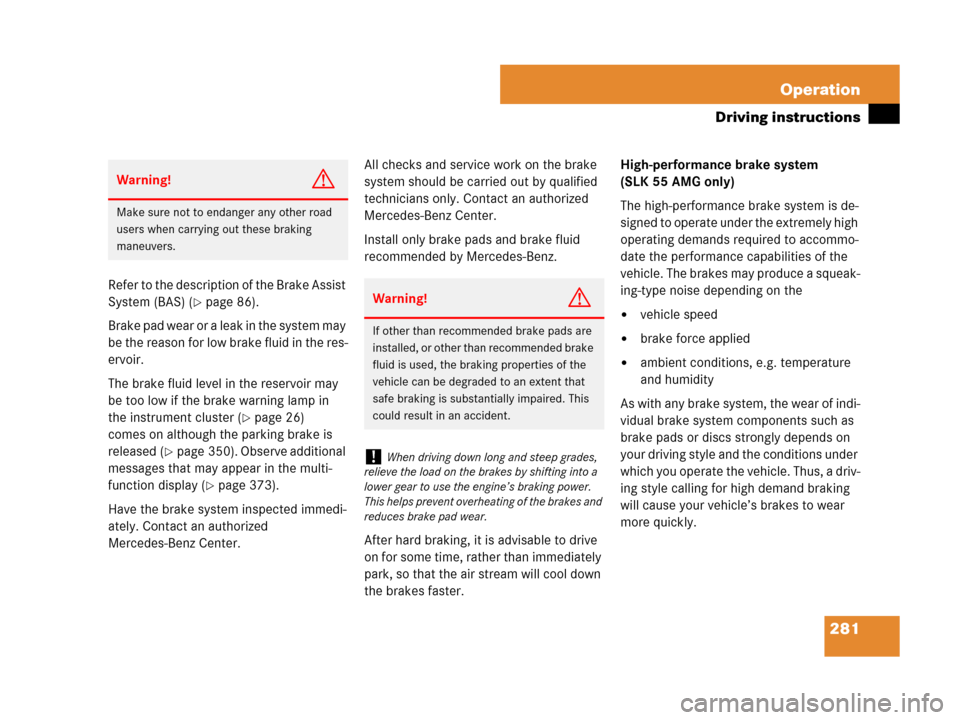
281 Operation
Driving instructions
Refer to the description of the Brake Assist
System (BAS) (
�page 86).
Brake pad wear or a leak in the system may
be the reason for low brake fluid in the res-
ervoir.
The brake fluid level in the reservoir may
be too low if the brake warning lamp in
the instrument cluster (
�page 26)
comes on although the parking brake is
released (
�page 350). Observe additional
messages that may appear in the multi-
function display (
�page 373).
Have the brake system inspected immedi-
ately. Contact an authorized
Mercedes-Benz Center.All checks and service work on the brake
system should be carried out by qualified
technicians only. Contact an authorized
Mercedes-Benz Center.
Install only brake pads and brake fluid
recommended by Mercedes-Benz.
After hard braking, it is advisable to drive
on for some time, rather than immediately
park, so that the air stream will cool down
the brakes faster.High-performance brake system
(SLK 55 AMG only)
The high-performance brake system is de-
signed to operate under the extremely high
operating demands required to accommo-
date the performance capabilities of the
vehicle. The brakes may produce a squeak-
ing-type noise depending on the
�vehicle speed
�brake force applied
�ambient conditions, e.g. temperature
and humidity
As with any brake system, the wear of indi-
vidual brake system components such as
brake pads or discs strongly depends on
your driving style and the conditions under
which you operate the vehicle. Thus, a driv-
ing style calling for high demand braking
will cause your vehicle’s brakes to wear
more quickly.
Warning!G
Make sure not to endanger any other road
users when carrying out these braking
maneuvers.
Warning!G
If other than recommended brake pads are
installed, or other than recommended brake
fluid is used, the braking properties of the
vehicle can be degraded to an extent that
safe braking is substantially impaired. This
could result in an accident.
!When driving down long and steep grades,
relieve the load on the brakes by shifting into a
lower gear to use the engine’s braking power.
This helps prevent overheating of the brakes and
reduces brake pad wear.
Page 283 of 474
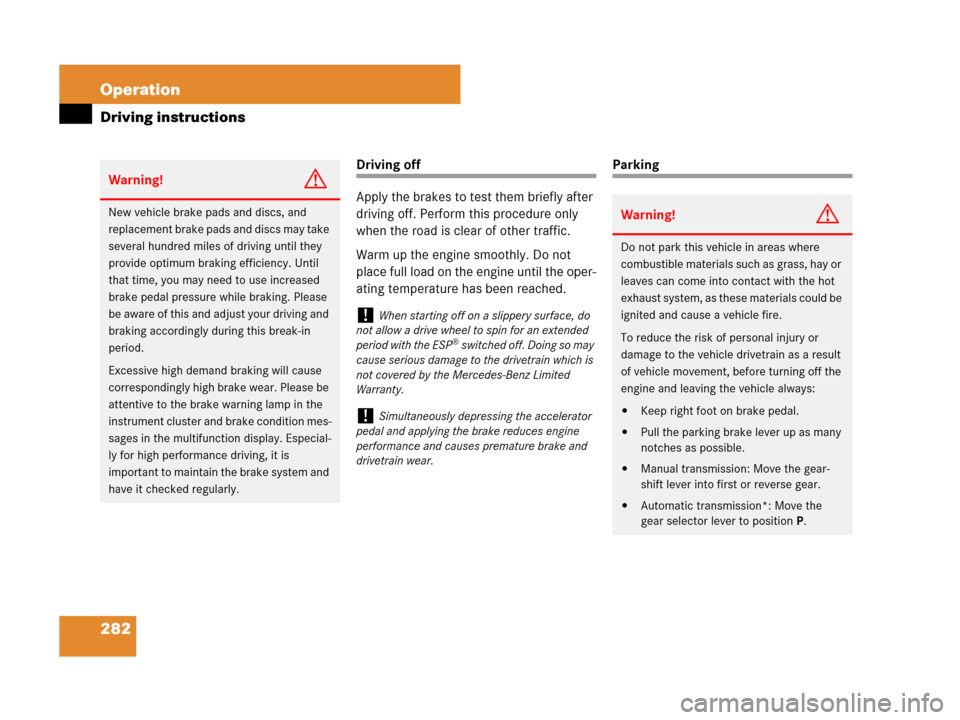
282 Operation
Driving instructions
Driving off
Apply the brakes to test them briefly after
driving off. Perform this procedure only
when the road is clear of other traffic.
Warm up the engine smoothly. Do not
place full load on the engine until the oper-
ating temperature has been reached.Parking
Warning!G
New vehicle brake pads and discs, and
replacement brake pads and discs may take
several hundred miles of driving until they
provide optimum braking efficiency. Until
that time, you may need to use increased
brake pedal pressure while braking. Please
be aware of this and adjust your driving and
braking accordingly during this break-in
period.
Excessive high demand braking will cause
correspondingly high brake wear. Please be
attentive to the brake warning lamp in the
instrument cluster and brake condition mes-
sages in the multifunction display. Especial-
ly for high performance driving, it is
important to maintain the brake system and
have it checked regularly.
!When starting off on a slippery surface, do
not allow a drive wheel to spin for an extended
period with the ESP
® switched off. Doing so may
cause serious damage to the drivetrain which is
not covered by the Mercedes-Benz Limited
Warranty.
!Simultaneously depressing the accelerator
pedal and applying the brake reduces engine
performance and causes premature brake and
drivetrain wear.
Warning!G
Do not park this vehicle in areas where
combustible materials such as grass, hay or
leaves can come into contact with the hot
exhaust system, as these materials could be
ignited and cause a vehicle fire.
To reduce the risk of personal injury or
damage to the vehicle drivetrain as a result
of vehicle movement, before turning off the
engine and leaving the vehicle always:
�Keep right foot on brake pedal.
�Pull the parking brake lever up as many
notches as possible.
�Manual transmission: Move the gear-
shift lever into first or reverse gear.
�Automatic transmission*: Move the
gear selector lever to position P.
Page 351 of 474
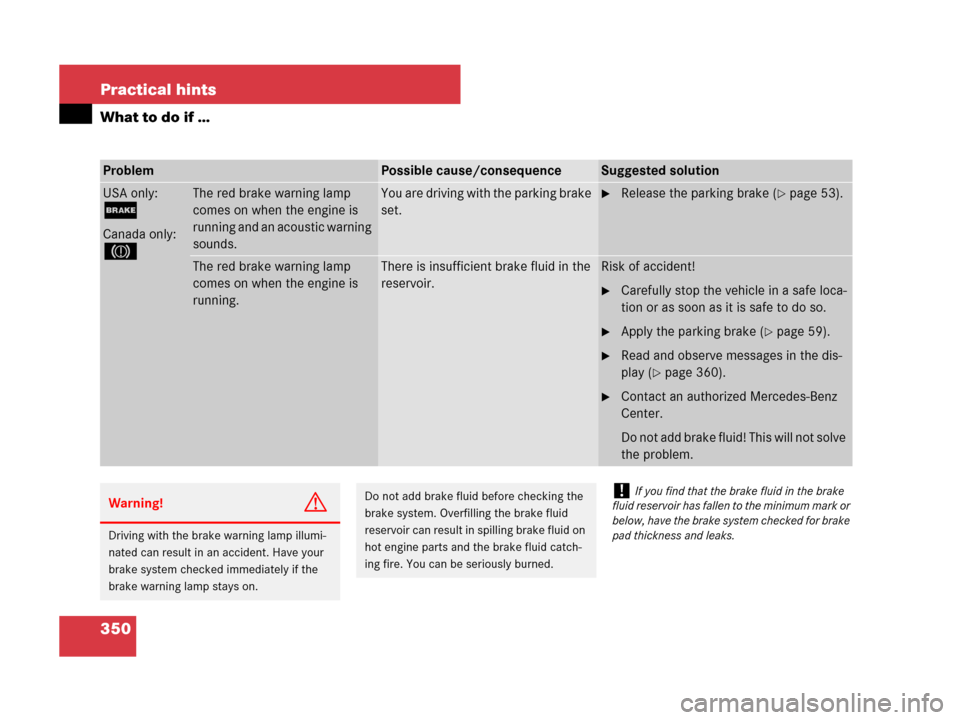
350 Practical hints
What to do if …
ProblemPossible cause/consequenceSuggested solution
USA only:
;
Canada only:
3
The red brake warning lamp
comes on when the engine is
running and an acoustic warning
sounds.You are driving with the parking brake
set.�Release the parking brake (�page 53).
The red brake warning lamp
comes on when the engine is
running.There is insufficient brake fluid in the
reservoir.Risk of accident!
�Carefully stop the vehicle in a safe loca-
tion or as soon as it is safe to do so.
�Apply the parking brake (�page 59).
�Read and observe messages in the dis-
play (
�page 360).
�Contact an authorized Mercedes-Benz
Center.
Do not add brake fluid! This will not solve
the problem.
Warning!G
Driving with the brake warning lamp illumi-
nated can result in an accident. Have your
brake system checked immediately if the
brake warning lamp stays on.
Do not add brake fluid before checking the
brake system. Overfilling the brake fluid
reservoir can result in spilling brake fluid on
hot engine parts and the brake fluid catch-
ing fire. You can be seriously burned.!If you find that the brake fluid in the brake
fluid reservoir has fallen to the minimum mark or
below, have the brake system checked for brake
pad thickness and leaks.
Page 366 of 474
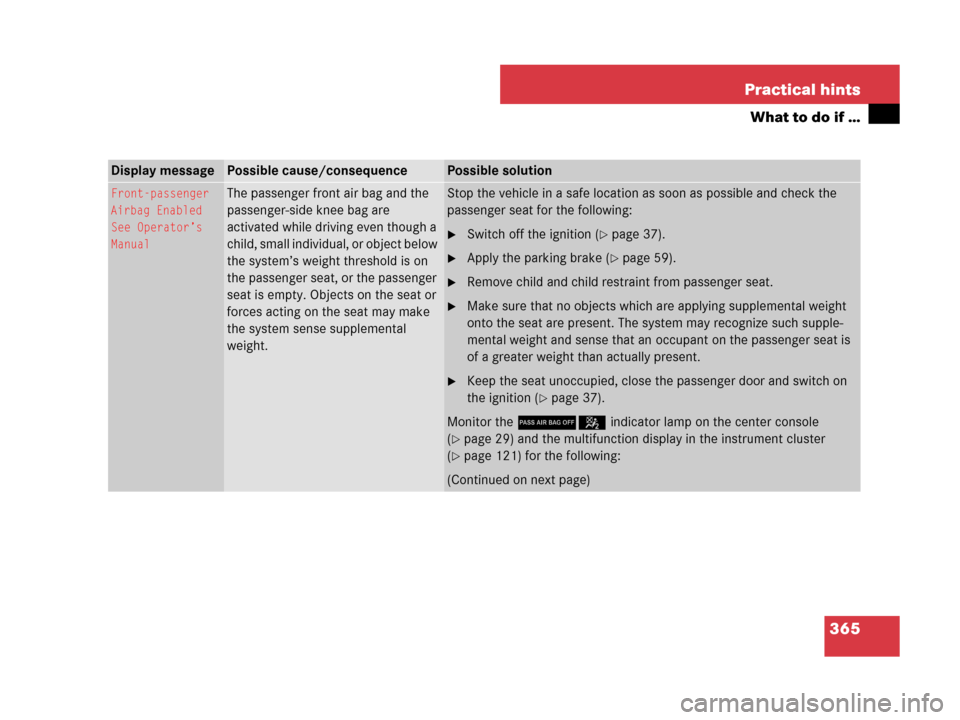
365 Practical hints
What to do if …
Display message Possible cause/consequencePossible solution
Front-passenger
Airbag Enabled
See Operator’s
ManualThe passenger front air bag and the
passenger-side knee bag are
activated while driving even though a
child, small individual, or object below
the system’s weight threshold is on
the passenger seat, or the passenger
seat is empty. Objects on the seat or
forces acting on the seat may make
the system sense supplemental
weight.Stop the vehicle in a safe location as soon as possible and check the
passenger seat for the following:
�Switch off the ignition (�page 37).
�Apply the parking brake (�page 59).
�Remove child and child restraint from passenger seat.
�Make sure that no objects which are applying supplemental weight
onto the seat are present. The system may recognize such supple-
mental weight and sense that an occupant on the passenger seat is
of a greater weight than actually present.
�Keep the seat unoccupied, close the passenger door and switch on
the ignition (
�page 37).
Monitor the 75indicator lamp on the center console
(
�page 29) and the multifunction display in the instrument cluster
(
�page 121) for the following:
(Continued on next page)
Page 368 of 474
367 Practical hints
What to do if …
Display messagePossible cause/consequencePossible solution
Front-passenger
Airbag Disabled
See Operator’s
ManualThe passenger front air bag and the
passenger-side knee bag are
deactivated while driving even though
an adult or someone larger than a
small individual is occupying the front
passenger seat. Forces acting on the
seat may make the system sense a
decrease in weight.Stop the vehicle in a safe location as soon as possible and check the
passenger seat for the following:
�Switch off the ignition (�page 37).
�Apply the parking brake (�page 59).
�Have the passenger vacate the seat and exit the vehicle.
�Keep the seat unoccupied, close the passenger door and switch on
the ignition (
�page 37).
Monitor the 75indicator lamp on the center console
(
�page 29) and the multifunction display in the instrument cluster
(
�page 121) for the following:
(Continued on next page)
Page 372 of 474
371 Practical hints
What to do if …
Symbol messages
Display symbolDisplay messagePossible cause/consequencePossible solution
ÊThis message will appear whenever
the trunk lid is open.�Close the trunk lid.
OYou are driving with the hood open.Risk of accident!
�Stop the vehicle in a safe location or as soon
as it is safe to do so.
�Apply the parking brake (�page 59).
�Close the hood (�page 294).
JYou are driving with one or more
doors open.�Close the doors.
•The cooling fan for the coolant is
malfunctioning.�Observe the coolant temperature display
(
�page 127).
If the coolant temperature is below 120°C,
you may continue driving to the nearest
specialist workshop.
�Avoid heavy loads on the engine (e.g. by
driving uphill) as well as stop-and-go traffic.
�Have the fan replaced as soon as possible.
Page 373 of 474
372 Practical hints
What to do if …
Display symbolDisplay messagePossible cause/consequencePossible solution
#The battery is no longer charging.
Possible causes:
�Alternator malfunctioning
�Broken poly-V-belt
Do not forget that the brake system
requires electrical energy and may
be operating with restricted capa-
bility. Considerably greater brake
pedal force is required and the stop-
ping distance is increased.
�Stop the vehicle immediately in a safe loca-
tion and check the poly-V-belt.
If it is broken:
�Do not continue to drive.
Otherwise, the engine will overheat due
to an inoperative water pump which may
result in damage to the engine. Contact
an authorized Mercedes-Benz Center.
If it is in order:
�Contact an Mercedes-Benz Center
immediately. Adjust driving to be consis-
tent with reduced braking responsive-
ness.
USA only:
;
Canada only:
!
Release
Parking BrakeYou are driving with the parking
brake set.�Release the parking brake (�page 53).
Page 374 of 474
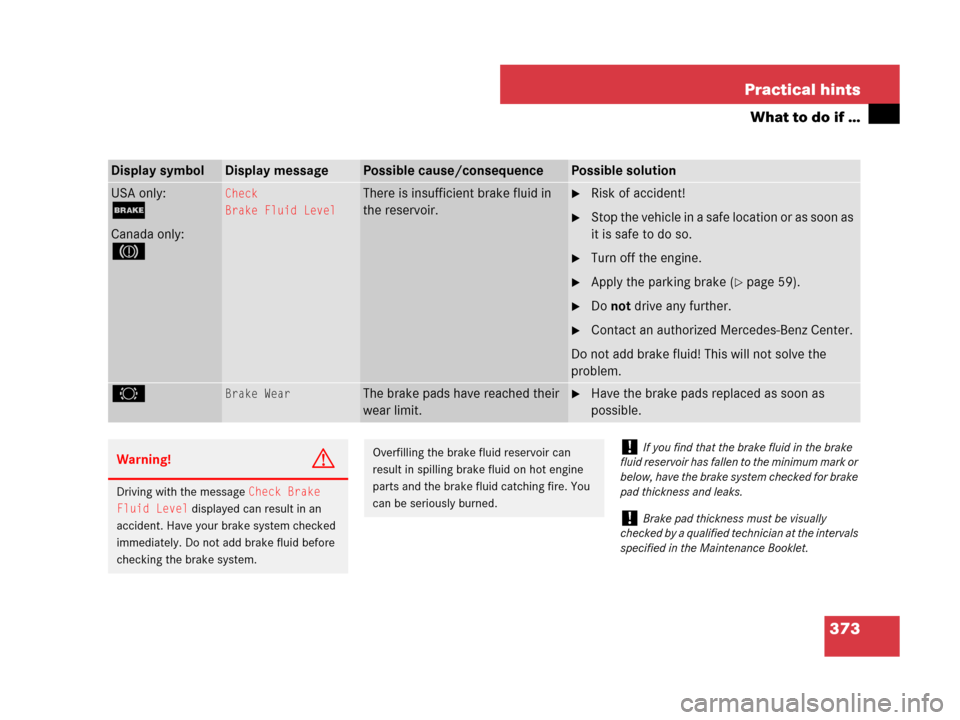
373 Practical hints
What to do if …
Display symbolDisplay messagePossible cause/consequencePossible solution
USA only:
;
Canada only:
3
Check
Brake Fluid LevelThere is insufficient brake fluid in
the reservoir.�Risk of accident!
�Stop the vehicle in a safe location or as soon as
it is safe to do so.
�Turn off the engine.
�Apply the parking brake (�page 59).
�Do not drive any further.
�Contact an authorized Mercedes-Benz Center.
Do not add brake fluid! This will not solve the
problem.
2Brake WearThe brake pads have reached their
wear limit.�Have the brake pads replaced as soon as
possible.
Warning!G
Driving with the message Check Brake
Fluid Level
displayed can result in an
accident. Have your brake system checked
immediately. Do not add brake fluid before
checking the brake system.
Overfilling the brake fluid reservoir can
result in spilling brake fluid on hot engine
parts and the brake fluid catching fire. You
can be seriously burned.!If you find that the brake fluid in the brake
fluid reservoir has fallen to the minimum mark or
below, have the brake system checked for brake
pad thickness and leaks.
!Brake pad thickness must be visually
checked by a qualified technician at the intervals
specified in the Maintenance Booklet.